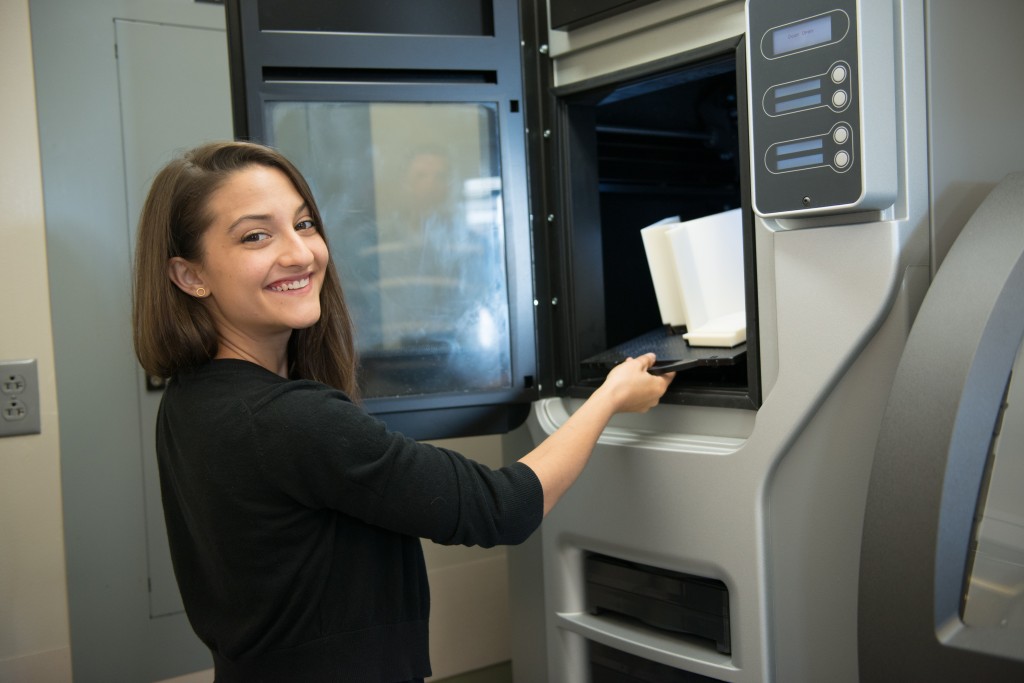 Since launching its groundbreaking 3D Printing Initiative just over a year ago, SUNY New Paltz has quickly become the premiere hub for advanced manufacturing technology in the Hudson Valley.
Since launching its groundbreaking 3D Printing Initiative just over a year ago, SUNY New Paltz has quickly become the premiere hub for advanced manufacturing technology in the Hudson Valley.
Thanks to recent funding and the addition of new staff and equipment, the Hudson Valley Advanced Manufacturing Center (HVAMC) is providing digital design and fabrication expertise to about 35 businesses and entrepreneurs throughout the region.
“The Center has completed numerous projects for companies and individuals and inquiries from business and industry continue to grow,” said Dan Freedman, director of the HVAMC and dean of the School of Science and Engineering.
“Our vision for the Hudson Valley 3D Printing (HV3D) initiative was to quickly move this burgeoning technology from the classroom to real-world applications for regional businesses,” added Laurence Gottlieb, president & CEO of Hudson Valley Economic Development Corporation. “The SUNY New Paltz team has exceeded even our wildest expectations, as we are now positively impacting the Hudson Valley economy in so many new and exciting ways.”
Freedman’s counterpart New Paltz alumna Katherine Wilson ’14g (Metal), who was hired this fall as the Center’s assistant director, said the HVAMC has worked on 3D projects ranging from electronics enclosures to a bouquet holder to industrial venting systems.
“We work with the businesses from a variety of industries to do anything from the printing of files to product design and development,” said Wilson, who noted that the acquisition of new machines, including a 3D Systems PROJET 660 and Stratasys Fortus 400mc, are helping to produce quality 3D printed projects in a turnaround time that’s quick and efficient.
In addition to her role as assistant director, Wilson teaches courses in the College’s Digital Design and Fabrication (DDF) certificate program. Working with new hires Aaron Nelson, instructional support technician, and assistant professor Michael Gayk (Metal/Digital Design and Fabrication), Wilson said the DDF curriculum is designed to provide a comprehensive introduction to creating digital designs that can be fabricated on a 3D printer.
“3D printing gives you a very fast path from idea to generation to creation,” said Nelson, who previously held positions at the University of Arkansas and the Fay Jones School of Architecture. “You can iterate quickly; designing, printing, making changes and then printing the revised part. It gives artists, designers and engineers a new tool to quickly work through and test ideas.”
“This type of personalization is appealing to consumers and industries running the gamut from art to science,” said Paul Kassel, interim dean of the School of Fine and Performing Arts.
He noted that this notion has guided New Paltz’s 3D Printing Initiative from its inception.
“Our 3D efforts reflect the College’s ongoing effort to integrate its strengths in engineering, computer science, technology, and the innovation and creativity of the arts,” Kassel said. “What’s exciting to see is the alliance between science and art, and the possibilities in the future.”
About New Paltz’s 3D Printing Initiative
Since launching the Hudson Valley Advanced Manufacturing Center in spring 2013, the College’s effort to fuse learning and manufacturing, science and the arts has continued to gain momentum. In February 2014, the College partnered with Brooklyn, N.Y. – based MakerBot, the leading manufacturer of desktop 3D printers, to open the nation’s first MakerBot Innovation Center at SUNY New Paltz. The 3D Printing Initiative received additional funding in fall 2014, including a $10 million NYSUNY 2020 Challenge Grant to help establish an Engineering Innovation Hub and $850,000 in capital funding for a new 3D Printing Laboratory. In December 2013, the Mid-Hudson Regional Economic Development Council and Governor Andrew Cuomo awarded the College $1M in state economic development funds. Currently, the HVAMC is providing digital design and fabrication expertise to about 50 businesses and entrepreneurs throughout the region. The Center also engages the local community and educates the public about the possibilities of 3D printing. Workshops for K-12 educators have attracted a wide variety of teachers, from art to science, who have an interest in digital design and fabrication and are utilizing these new technologies in their classrooms.

